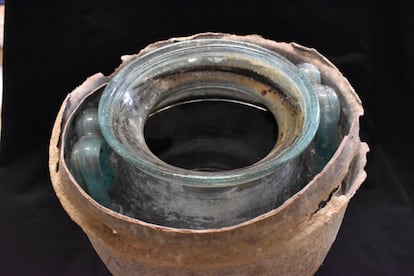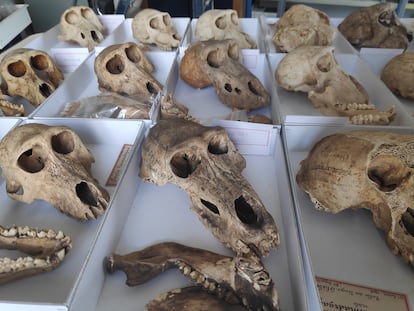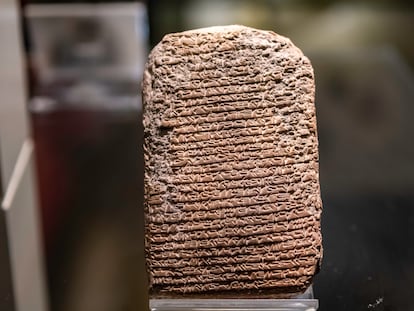The oldest wine in the world has been preserved in a Roman mausoleum in Spain for 2,000 years
A team from the University of Córdoba found the liquid in the necropolis of the Andalusian town of Carmona. Their analysis suggests the new finding supersedes the Speyer wine bottle in Germany

The oldest wine in the world, over 2,000 years old, has been discovered at a Roman necropolis in Carmona, a city in the southern Spanish region of Andalusia. A team from the Department of Organic Chemistry of the University of Córdoba, led by Professor José Rafael Ruiz Arrebola, in collaboration with Carmona City Council, made the discovery. The finding supersedes the Speyer wine bottle, discovered in 1867 and dated between 325 and 350 AD, which is preserved in the Historical Museum of Pfalz (Germany) and considered the world’s oldest known bottle of wine.
In a media release, the Scientific Culture and Innovation Unit, dependent on the Ministry of Science and Innovation, said that Hispana, Senicio and the other four bodies (two men and two women) discovered inside a Roman tomb in Carmona in 2019, “never imagined that what for them was just a funerary ritual would end up being relevant 2,000 years later for another reason.”
The funerary ritual, it has been discovered, immersed the skeletal remains of one of the men in a liquid inside a glass funerary urn. This liquid, which over time has acquired a reddish hue, has been preserved since the 1st century AD. “At first we were very surprised that this liquid was preserved in one of the funerary urns,” explained the municipal archaeologist of Carmona, Juan Manuel Román. However, the good conservation conditions of the tomb, which has been preserved “intact and well sealed” during all this time, “is what made it possible for the wine to maintain its natural state and to rule out other possible causes for this liquid, such as flooding or leaks inside the chamber, or condensation processes.”
The challenge for researchers was to verify the suspicions that “the reddish liquid was wine or, rather, that at another time it had been wine, because it had already lost many of its essential characteristics.” To clarify this point, they turned to a series of chemical analyses carried out at Córdoba University. Their findings were published in the Journal of Archaeological Science: Reports, where researchers said that “an archaeochemical study of the liquid allowed it to be deemed the oldest ancient wine conserved in the liquid state.”
“Given the religious significance of wine in the Ancient Roman world, where it was highly symbolic and closely related to burial rituals, it is unsurprising to find vessels that might have originally contained wines among burial furnishings. Consequently, the reddish liquid found in the urn might be wine or vestiges of wine decomposed over time,” said the study.
The team used inductively coupled plasma mass spectrometry (ICP-MS) to determine the chemical elements in the mineral salts of the wine, and high-performance liquid chromatography-mass spectrometry (HPLC-MS) to identify the polyphenols it contained. “The mineral salt profile and, especially, the detection and quantification of some typical polyphenols, allowed the liquid to be identified as white wine,” said the report. The team found seven specific polyphenols that were also present in sherry wines from Montilla-Moriles, Jerez and Sanlúcar.
The team noted that the “most difficult” thing was determining the origin of the wine, since there is no sample from the same era to compare it to. Even so, the mineral salts present in the liquid from the tomb are consistent with the white wines currently produced in the territory of Andalusia, the ancient Roman province of Baetica.
The fact that wine covered the skeletal remains of a man is no coincidence. Women in Ancient Rome were prohibited from tasting wine. The two glass urns in Carmona’s tomb are an example of the gender division of Roman society and funerary rituals. The bones of a man were immersed in wine along with a gold ring and other bone remains from the funerary bed in which he had been cremated; the urn containing the remains of a woman did not have a single drop of wine, but three amber jewels, a perfume bottle with a scent of patchouli, and remains of fabric whose first analyses seem to indicate that they were silk.
In short, the wine, as well as the rings, perfume and other elements were part of a funerary trousseau that would accompany the deceased on their journey to the afterlife. In ancient Rome, death had a special meaning and people wanted to be remembered in order to, in some way, stay alive. This particular tomb, a circular mausoleum that probably housed a wealthy family, was located next to a major road that connected Carmona with Hispalis (Seville).
Rehabilitation work in a house in Carmona in 2019 unearthed a collective tomb belonging to the western necropolis of Carmo, an ancient Roman city, the researchers recall. The mausoleum was dated back to the early 1st century CE. Carmona is a city in the Guadalquivir valley, Western Andalusia, 18.6 miles west of Seville. Under Roman domination in the 1st and 2nd centuries AD, the city became an important municipality. It still retains a necropolis that is the largest and best conserved on the Iberian Peninsula, the study notes.
Sign up for our weekly newsletter to get more English-language news coverage from EL PAÍS USA Edition
Tu suscripción se está usando en otro dispositivo
¿Quieres añadir otro usuario a tu suscripción?
Si continúas leyendo en este dispositivo, no se podrá leer en el otro.
FlechaTu suscripción se está usando en otro dispositivo y solo puedes acceder a EL PAÍS desde un dispositivo a la vez.
Si quieres compartir tu cuenta, cambia tu suscripción a la modalidad Premium, así podrás añadir otro usuario. Cada uno accederá con su propia cuenta de email, lo que os permitirá personalizar vuestra experiencia en EL PAÍS.
¿Tienes una suscripción de empresa? Accede aquí para contratar más cuentas.
En el caso de no saber quién está usando tu cuenta, te recomendamos cambiar tu contraseña aquí.
Si decides continuar compartiendo tu cuenta, este mensaje se mostrará en tu dispositivo y en el de la otra persona que está usando tu cuenta de forma indefinida, afectando a tu experiencia de lectura. Puedes consultar aquí los términos y condiciones de la suscripción digital.










































